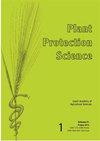Exploring the Effects of Plant Extracts, Biological Agents and Essential Oils on the Non-Chemical Management of Banana Leaf Spot Disease
IF 1.7
4区 农林科学
Q2 AGRONOMY
引用次数: 2
Abstract
The present research aimed to effectively manage Fusarium oxysporum, the causal agent of banana leaf spot disease, through the utilization of diverse botanical extracts, essential oils, and biocontrol agents. Various concentrations (5%, 10%, and 15%) of botanical extracts, namely Garlic, Turmeric, Ginger, Neem, and Mint, were tested to assess their antifungal efficacy. Garlic demonstrated complete inhibition of radial growth (0.00 mm), with decreasing growth observed in Neem, Turmeric, Ginger, and the most extensive growth seen in Mint (32.83, 21.33, and 16.25 mm, respectively). Antifungal effects of specific essential oils (Clove, Tarpin, Castor, Bitter chamomile, Neem) were evaluated using the poisoned food technique at the mentioned concentrations. Clove exhibited complete growth inhibition (0.00 mm), followed by Tarpin, Castor, and Neem. Conversely, Bitter Chamomile oil promoted maximum growth (35.41, 30.41, and 25.50 mm). Control plates displayed growth of 90 mm. The study also assessed different in vitro biocontrol agents (Trichoderma harzianum, Zasmidium anthuriicola, Penicillium sclerotiorum, Hypocrea lixii, and Chaetomium subaffine) against the target pathogen. Among these, Z. anthuriicola (18.41 mm) prevented F. oxysporum growth most effectively, followed by T. harzianum, P. sclerotiorum, C. subaffine, and H. lixii. While managing this destructive disease remains a significant challenge, the eco-friendly strategies employed in the study demonstrated that Garlic extract, Clove oil, and the biocontrol agent Z. anthuriicola substantially hindered the mycelial growth of the target pathogen.植物提取物、生物制剂和精油对香蕉叶斑病非化学防治效果的探讨
本研究旨在通过利用多种植物提取物、精油和生物防治剂,对香蕉叶斑病病原菌尖孢镰刀菌进行有效防治。不同浓度(5%、10%和15%)的植物提取物,即大蒜、姜黄、生姜、印度楝树和薄荷,进行了测试,以评估其抗真菌功效。大蒜完全抑制了植物径向生长(0.00 mm),印度楝树、姜黄和生姜的生长减少,薄荷的生长最广泛(分别为32.83、21.33和16.25 mm)。采用中毒食品法评价了丁香、蓖麻、苦洋甘菊、印度楝等特定精油在上述浓度下的抑菌效果。丁香表现出完全的生长抑制(0.00 mm),其次是蓖麻、蓖麻和楝树。相反,苦洋甘菊油促进最大生长(35.41、30.41和25.50 mm)。对照板显示生长90毫米。本研究还评估了不同的体外生物防治剂(哈茨木霉、红花紫霉、菌核青霉、李氏霉和亚仿射毛藻)对目标病原体的作用。其中,对尖孢镰刀菌(18.41 mm)的抑制作用最大,其次是哈兹镰刀菌、菌核镰刀菌、亚affine镰刀菌和lixii镰刀菌。尽管控制这种破坏性疾病仍然是一项重大挑战,但研究中采用的环保策略表明,大蒜提取物、丁香油和生物防治剂红花病菌(Z. anthuriicola)显著阻碍了目标病原体的菌丝生长。
本文章由计算机程序翻译,如有差异,请以英文原文为准。
求助全文
约1分钟内获得全文
求助全文
来源期刊

Plant protection science
Agronomy-PLANT SCIENCES
CiteScore
2.90
自引率
7.70%
发文量
30
审稿时长
12 weeks
期刊介绍:
Original papers, short communications, critical reviews, personal news, and book reviews covering all areas of diseases and pests of plants, weeds and plant protection. Papers are published in English.
 求助内容:
求助内容: 应助结果提醒方式:
应助结果提醒方式:


